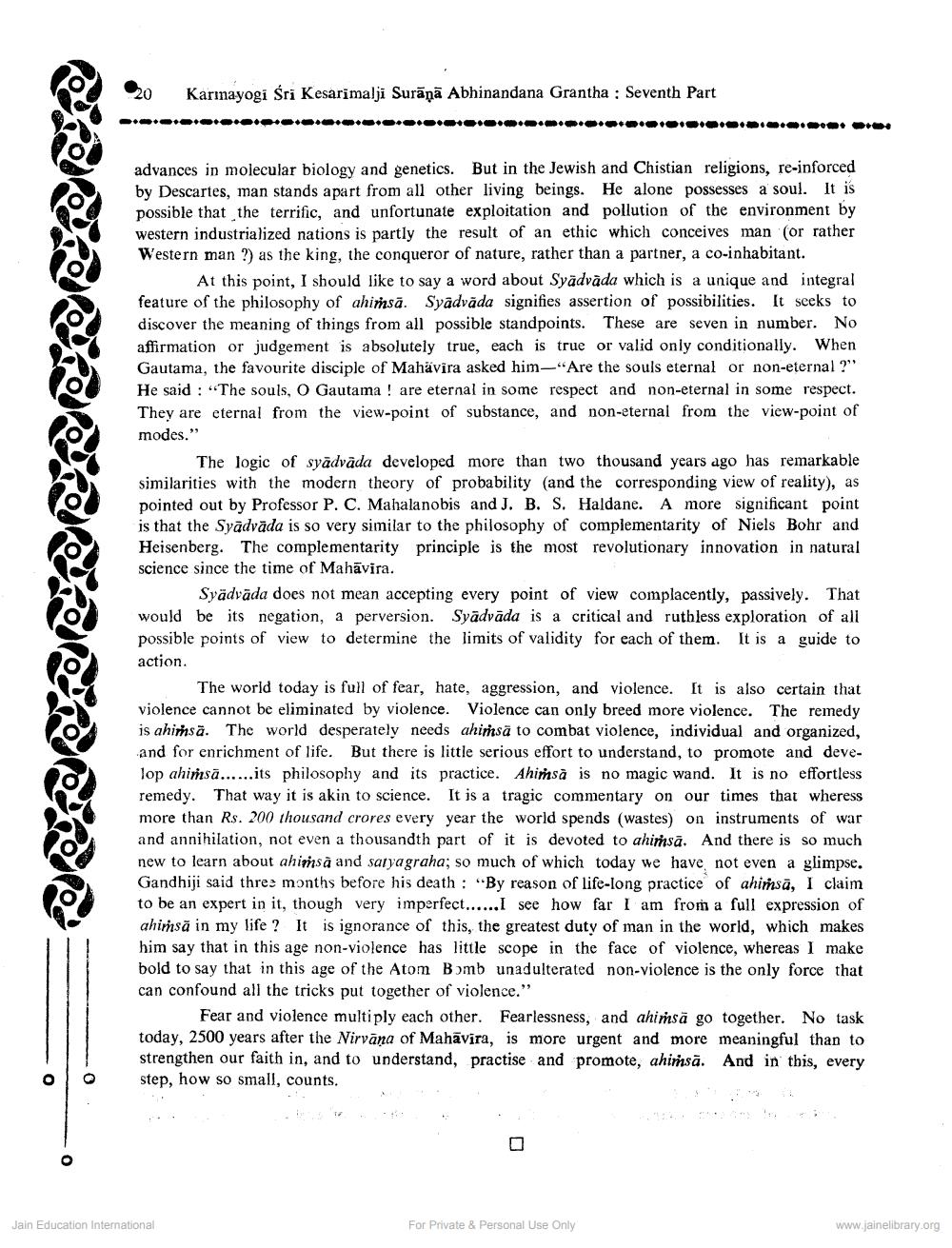________________
20
Karınayogi Śri Kesarimalji Surāņā Abhinandana Grantha : Seventh Part
advances in molecular biology and genetics. But in the Jewish and Chistian religions, re-inforced by Descartes, man stands apart from all other living beings. He alone possesses a soul. It is possible that the terrific, and unfortunate exploitation and pollution of the environment by western industrialized nations is partly the result of an ethic which conceives man (or rather Western man ?) as the king, the conqueror of nature, rather than a partner, a co-inhabitant.
At this point, I should like to say a word about Syädvāda which is a unique and integral feature of the philosophy of ahimsā. Syadvāda signifies assertion of possibilities. It seeks to discover the meaning of things from all possible standpoints. These are seven in number. No affirmation or judgement is absolutely true, each is true or valid only conditionally. When Gautama, the favourite disciple of Mahävira asked him-"Are the souls eternal or non-eternal ?" He said: "The souls, O Gautama ! are eternal in some respect and non-eternal in some respect. They are eternal from the view-point of substance, and non-eternal from the view-point of modes."
The logic of syādvāda developed more than two thousand years ago has remarkable similarities with the modern theory of probability and the corresponding view of reality), as pointed out by Professor P. C. Mahalanobis and J. B. S. Haldane. A more significant point is that the Syadvāda is so very similar to the philosophy of complementarity of Niels Bohr and Heisenberg. The complementarity principle is the most revolutionary innovation in natural science since the time of Mahavira.
Syädvāda does not mean accepting every point of view complacently, passively. That would be its negation, a perversion. Syādvāda is a critical and ruthless exploration of all possible points of view to determine the limits of validity for each of them. It is a guide to action.
The world today is full of fear, hate, aggression, and violence. It is also certain that violence cannot be eliminated by violence. Violence can only breed more violence. The remedy is ahiṁsā. The world desperately needs ahiṁsā to combat violence, individual and organized, and for enrichment of life. But there is little serious effort to understand, to promote and develop ahińsā......its philosophy and its practice. Ahimsa is no magic wand. It is no effortless remedy. That way it is akin to science. It is a tragic commentary on our times that wheress more than Rs. 200 thousand crores every year the world spends (wastes) on instruments of war and annihilation, not even a thousandth part of it is devoted to ahirsā. And there is so much new to learn about ahimsa and sar yagraha; so much of which today we have not even a glimpse. Gandhiji said three months before his death : "By reason of life-long practice of ahimsā, I claim to be an expert in it, though very imperfect......I see how far I am from a full expression of ahirnsă in my life? It is ignorance of this, the greatest duty of man in the world, which makes him say that in this age non-violence has little scope in the face of violence, whereas I make bold to say that in this age of the Atom Bomb unadulterated non-violence is the only force that can confound all the tricks put together of violence."
Fear and violence multiply each other. Fearlessness, and ahinsä go together. No task today, 2500 years after the Nirvana of Mahāvīra, is more urgent and more meaningful than to strengthen our faith in, and to understand, practise and promote, ahimsā. And in this, every step, how so small, counts.
Jain Education International
For Private & Personal Use Only
www.jainelibrary.org




